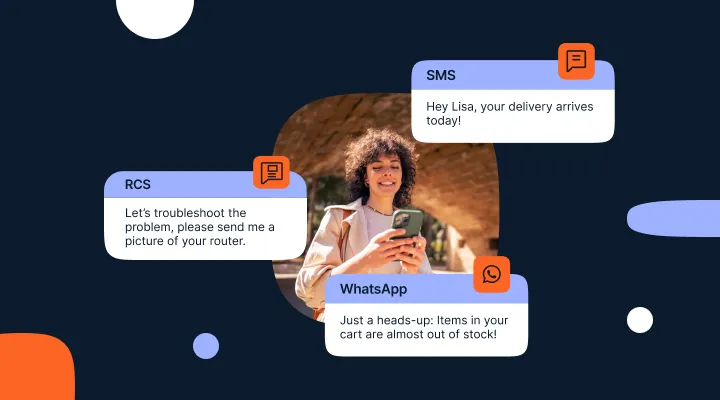What is AIML (Artificial Intelligence Markup Language)?
AIML, or Artificial Intelligence Markup Language, is an XML dialect developers use to create natural language software agents commonly used in chatbots.
They contain a collection of rules defining chatbots’ conversational capabilities and are used in conjunction with a linguistic communication understanding processor. The processor uses AIML rules to investigate and reply to text queries. The more rules added to AIML, the more intelligent a chatbot becomes.
AIML-based chatbots come under the rule-based chatbot category. However, some level of self-learning is involved, and the language used acts as the chatbot’s brain. One chatbot can have multiple sets of AIML, making them behave differently.
Richard Wallace is a key figure in the history of AIML. He’s considered the father of AIML, having created it in the late 1990s. He also created A.L.I.C.E. (Artificial Linguistic Internet Computer Entity), one of the first AIML-based chatbots.
What is artificial intelligence markup language used for?
AIML is a versatile language used to create natural language software agents like chatbots, virtual assistants, and other forms of artificial intelligence software.
In essence, AIML provides a framework for creating chatbots that can:
- Understand human language
- Learn and adapt to new information
- Engage in meaningful conversations
What are the basic concepts in artificial intelligence markup language?
AIML, at its core, revolves around a few key concepts that dictate how chatbots process information and generate responses. Here are the essentials:
- Categories: These are the building blocks of artificial intelligence markup language. Each category defines a specific conversational pattern and the corresponding response. Think of them as “if-then” rules: “If the user says X, then the bot replies with Y.”
- Patterns: Patterns are used to match user input. They are essentially text strings, potentially with wildcards, that capture the essence of what a user might say.
- Templates: Templates define the chatbot’s response to a matched pattern. They can be simple text strings or include variables, conditions, and other AIML tags to generate dynamic and contextually relevant responses.
- Wildcards: These are special symbols (* and _) used in patterns to match any word or phrase. This allows the chatbot to understand variations in user input and provide more flexible responses. For example, the pattern “MY NAME IS *” would match any input that starts with “My name is” followed by any name.
- Context: Artificial intelligence markup language provides mechanisms to maintain context within a conversation. This allows the chatbot to remember previous interactions and use that information to generate more meaningful responses. For example, the <that> tag allows the bot to refer to its previous output.
- Recursion: This powerful feature allows artificial intelligence markup language to call itself, enabling the chatbot to break down complex inputs into smaller parts and process them step by step.
- Predicates: These variables store information about the user or the conversation. They can be used to personalize responses or track the user’s preferences.
How does artificial intelligence markup language work?
Artificial intelligence markup language employs a pattern-matching technique to process user input and generate responses. Here’s a step-by-step breakdown of the process:
- Input processing: When users interact with an AIML-powered chatbot, their input is first processed to remove irrelevant characters or formatting. This ensures that the core message is extracted.
- Pattern matching: The processed input is compared against the patterns defined in the AIML categories. The chatbot searches for the closest matching pattern based on keywords, wildcards, and other criteria.
- Template retrieval: The corresponding template is retrieved once a matching pattern is found. This template contains the chatbot’s response, which can be a simple text string or a more complex structure with variables and AIML tags.
- Response generation: The chatbot then uses the template to generate a response. This may involve substituting variables with specific values, evaluating conditions, or even calling other AIML categories recursively.
- Output: Finally, the generated response is presented to the user, completing the interaction cycle.
For example:
XML
<category>
<pattern>WHAT IS YOUR NAME</pattern>
<template>My name is Chatbot.</template>
</category>
If a user inputs “What is your name?”, the chatbot will:
- Process the input: “What is your name?”
- Match the pattern: The input matches the pattern “WHAT IS YOUR NAME”.
- Retrieve the template: The corresponding template is “My name is Chatbot.”
- Generate the response: The response is simply the template content.
- Output: The chatbot responds with “My name is Chatbot.”
What are some applications of AIML?
Artificial intelligence markup language, with its ability to enable human-like conversations, has found its way into various applications across different industries. Here are some notable examples:
- Customer service: Artificial intelligence markup language powers chatbots that provide instant customer support, answer frequently asked questions, and resolve issues 24/7. This improves response times, reduces customer service costs, and enhances customer satisfaction.
- Virtual assistants: AIML is used to create virtual assistants that can perform tasks like scheduling appointments, sending emails, setting reminders, and providing information. Popular examples include Siri, Alexa, and Google Assistant.
- Education: AIML-powered chatbots can act as tutors, providing personalized learning experiences, answering student questions, and offering feedback. They can also be used to create interactive educational games and simulations.
- Healthcare: Artificial intelligence markup language can be used to develop chatbots that provide basic medical advice, answer health-related questions, and even offer mental health support. This can improve access to healthcare information and reduce the burden on healthcare professionals.
- eCommerce: AIML-powered chatbots can assist customers with product recommendations, provide personalized shopping advice, and guide them through purchasing. This can improve sales and enhance the overall shopping experience.
- Travel and hospitality: Chatbots can help travelers book flights, hotels, and rental cars, provide information about tourist attractions, and offer personalized travel recommendations.
Challenges with AIML
While AIML offers a robust framework for building chatbots, it does come with its own set of challenges:
- Limited understanding of natural language: Artificial intelligence markup language relies heavily on pattern matching, which can be rigid. It struggles with the nuances of human language, such as sarcasm, idioms, and complex sentence structures. This can lead to misinterpretations and irrelevant responses.
- Difficulty in handling context: While AIML provides some mechanisms for maintaining context, it can still be challenging to create chatbots that truly understand and remember the flow of a conversation. This can result in disjointed and repetitive interactions.
- Maintenance and scalability: As the chatbot’s knowledge base grows, managing and updating the AIML code can become complex and time-consuming.
- Limited emotional intelligence: AIML chatbots lack emotional intelligence and cannot understand or respond to human emotions. This can make interactions feel impersonal and robotic.
- Security concerns: AIML chatbots can be vulnerable to security threats, especially if poorly designed and implemented. Malicious users could exploit vulnerabilities to access sensitive information or disrupt the chatbot’s functionality.
- Ethical considerations: As with any AI technology, AIML raises ethical concerns, such as bias in training data, potential job displacement, and the impact on human interaction.
FAQs about AIML
Keep on exploring
Read some of our latest blog posts

The ultimate guide to generative AI chatbots for customer service
Learn how generative AI, agentic AI, and agentic RAG technology are transforming CX. Explore use cases, benefits, risks, and best practices.

AI chatbots for healthcare: A guide for medical centers and healthcare providers
Learn how AI chatbots help healthcare providers boost patient care, efficiency, and privacy. See real-world examples and tips for safe medical chatbot integration.

How retail chatbots can personalize shopping experience
Shoppers expect quick, helpful responses. Retail chatbots have become a popular tool for brands to meet that demand. Learn how they’re transforming the way companies interact with their customers.

Chatbots vs. conversational AI: Exploring the differences
Discover the differences, benefits, and uses of chatbots and conversational AI to transform your business and enhance customer engagement.

Integrate conversational AI chatbots: A how-to guide
Learn how to integrate conversational AI chatbots seamlessly with your platform to elevate your customer engagement and automate support.

Chatbots for HR: Transforming employee engagement and operations
Learn how to keep employees satisfied and engaged with an always-on assistant to support HR departments manage daily tasks and requests.

From hype to hero: How chatbots can revolutionize your bank’s customer experience
Dive into practical applications of banking chatbots, voice-activated solutions, and generative AI that are already transforming banking experiences.

Beyond Automation: How insurance chatbots can provide a conversational experience
Conversational and generative AI are set to change the insurance industry. Read about how using an AI chatbot can shape conversational customer experiences for insurance companies and scale their marketing, sales, and support.

Demystifying finance AI chatbots for fintech firms
Finance AI chatbots are redefining how financial businesses serve customers. Does this mean your fintech company needs a finance AI chatbot? Find out in this blog.








